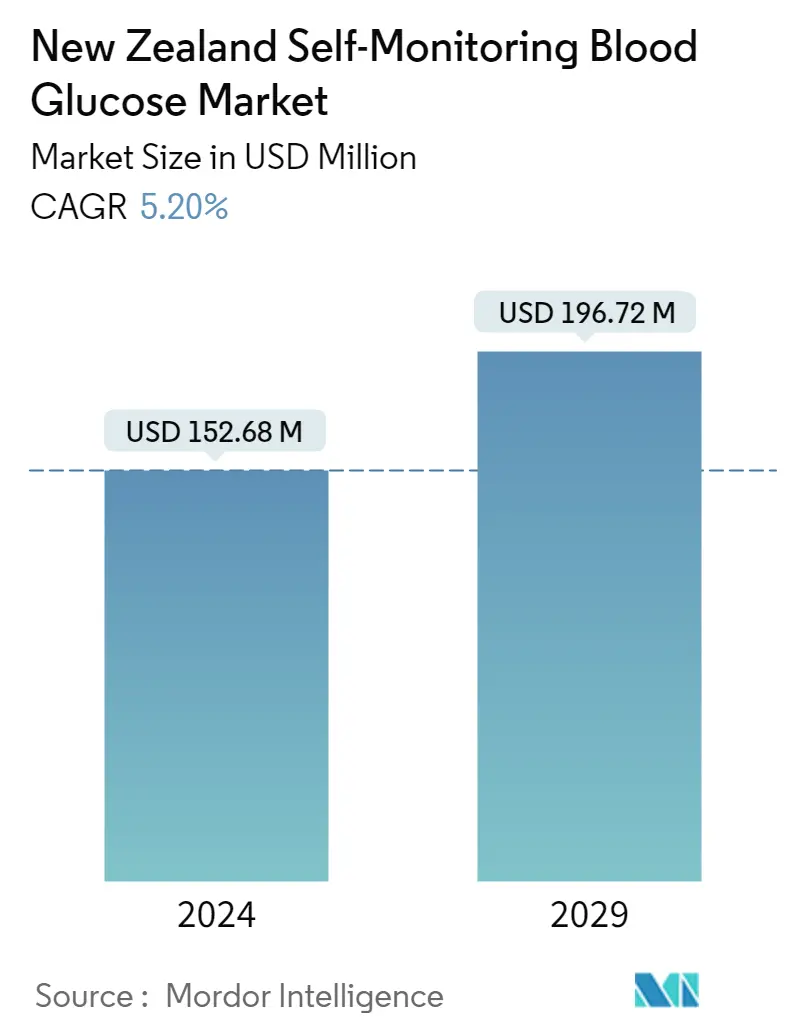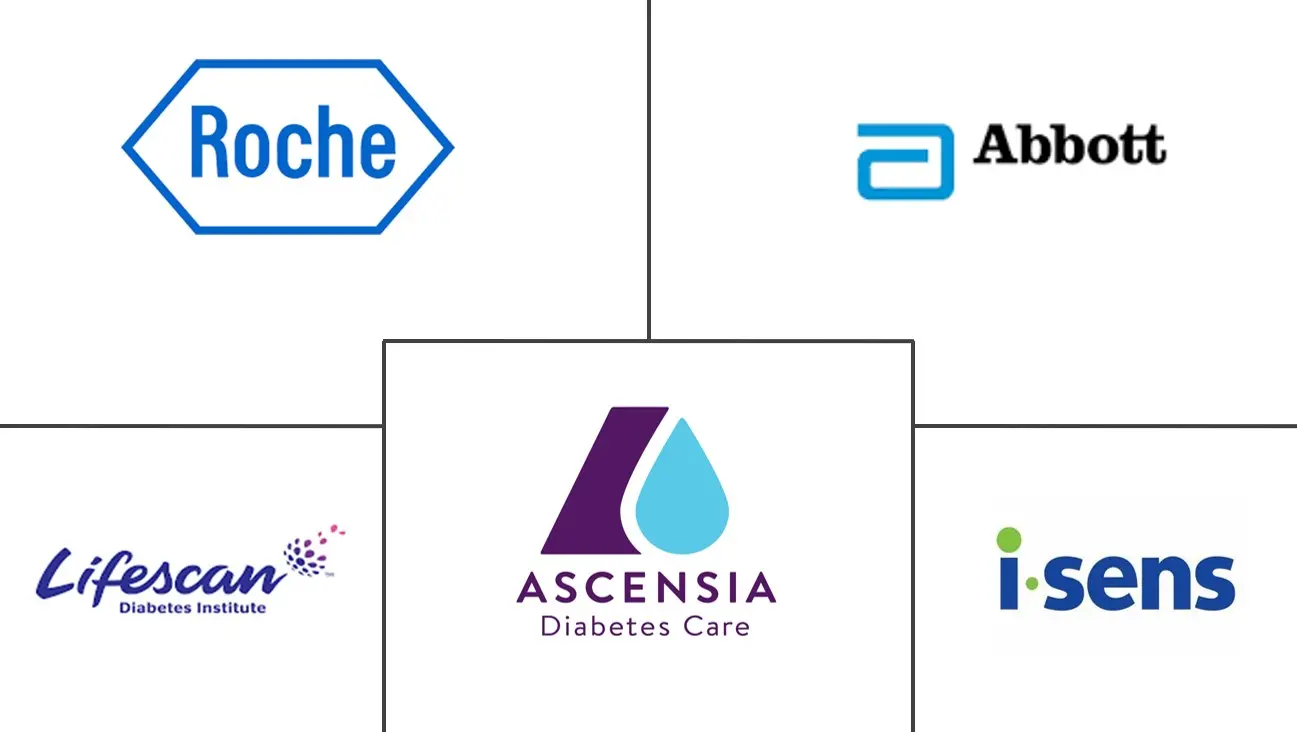Market Size of New Zealand Self-Monitoring Blood Glucose Industry

| Study Period | 2019 - 2029 |
| Base Year For Estimation | 2023 |
| Forecast Data Period | 2024 - 2029 |
| Market Size (2024) | USD 152.68 Million |
| Market Size (2029) | USD 196.72 Million |
| CAGR (2024 - 2029) | 5.20 % |
Major Players
*Disclaimer: Major Players sorted in no particular order |
New Zealand Self-Monitoring Blood Glucose Market Analysis
The New Zealand Self-Monitoring Blood Glucose Market size is estimated at USD 152.68 million in 2024, and is expected to reach USD 196.72 million by 2029, growing at a CAGR of 5.20% during the forecast period (2024-2029).
The COVID-19 pandemic showed that diabetes needs a lot more attention if we don't want the infection to cause problems that aren't necessary or fair.All the steps needed to protect this high-risk group were taken and kept up. For example, there were national public health measures to stop the spread of the disease, vaccinations were given, and workplace risk assessments were done.Additionally, it was crucial to guarantee that people with diabetes continue to receive regular evaluations from their primary care or diabetes-specific healthcare providers.For people who were in the hospital, it was important to get good glycemic control and aim for blood glucose levels between 4 and 10 mmol/L. If possible, diabetes specialist teams should be brought in early to prevent bad outcomes.
When a person with diabetes has high blood glucose levels that don't go down, it can cause damage to the kidneys, nerves, and eyes. Blood glucose measurement helps figure out how well blood glucose is being used by the body and shows how to get the best glucose control in the body. Over time, the readings give the patient and their doctors the information they need to figure out the best way to treat diabetes.When blood glucose levels are too high or too low, they can be managed successfully, which keeps health problems related to diabetes to a minimum.
Technology improvements in blood glucose meters, like ones that connect to cellular networks and automatically upload SMBG data to secure cloud-based databases, make it easier to share and track SMBG data. Real-time monitoring of SMBG data gives doctors the chance to help patients who respond to abnormal SMBG recordings right away. Such benefits can give people with T2D that aren't well controlled the extra help they need to improve critical outcomes, which will improve the market's chances in the years to come.
New Zealand Self-Monitoring Blood Glucose Industry Segmentation
Diabetic patients can measure their own blood sugar levels using a glucometer, test strips, and lancets by self-monitoring their blood glucose. Based on the readings, patients can adjust or check the effect of their treatment. The New Zealand market for self-monitoring blood glucose is segmented into components (glucometer devices, test strips, and lancets). The report offers the value (in USD million) and volume (in million units) for the above segments.
| Component (Value and Volume, 2017 - 2028) | |
| Glucometer Devices | |
| Test Strips | |
| Lancets |
New Zealand Self-Monitoring Blood Glucose Market Size Summary
The New Zealand self-monitoring blood glucose market is poised for significant growth over the forecast period, driven by advancements in technology and an increasing prevalence of diabetes. The market is characterized by the adoption of innovative blood glucose meters that offer features such as cellular connectivity and real-time data sharing, enhancing the management of diabetes. These technological improvements facilitate timely interventions by healthcare providers, thereby improving patient outcomes. The market landscape is moderately fragmented, with key players like Abbott, LifeScan, and Ascensia holding substantial market shares. The government's support through funding and initiatives by PHARMAC further bolsters the market's expansion, ensuring the availability of essential diagnostic tools.
The market's growth trajectory is also influenced by the rising number of diabetes cases in New Zealand, particularly among high-risk groups such as Mori and Pasifika populations. The increasing awareness of diabetes management and the critical role of self-monitoring in preventing complications are pivotal in driving market demand. Test strips, a crucial component of blood glucose testing, dominate the market due to their frequent usage and ongoing necessity. The market's expansion is supported by the continuous development of highly sensitive glucometers and test strips, which provide accurate readings and facilitate effective diabetes management. As the market evolves, it is expected to witness a robust increase in adoption, driven by both technological advancements and the growing need for effective diabetes care solutions.
New Zealand Self-Monitoring Blood Glucose Market Size - Table of Contents
-
1. MARKET DYNAMICS
-
1.1 Market Overview
-
1.2 Market Drivers
-
1.3 Market Restraints
-
1.4 Porter's Five Forces Analysis
-
1.4.1 Bargaining Power of Suppliers
-
1.4.2 Bargaining Power of Consumers
-
1.4.3 Threat of New Entrants
-
1.4.4 Threat of Substitute Products and Services
-
1.4.5 Intensity of Competitive Rivalry
-
-
-
2. MARKET SEGMENTATION
-
2.1 Component (Value and Volume, 2017 - 2028)
-
2.1.1 Glucometer Devices
-
2.1.2 Test Strips
-
2.1.3 Lancets
-
-
New Zealand Self-Monitoring Blood Glucose Market Size FAQs
How big is the New Zealand Self-Monitoring Blood Glucose Market?
The New Zealand Self-Monitoring Blood Glucose Market size is expected to reach USD 152.68 million in 2024 and grow at a CAGR of 5.20% to reach USD 196.72 million by 2029.
What is the current New Zealand Self-Monitoring Blood Glucose Market size?
In 2024, the New Zealand Self-Monitoring Blood Glucose Market size is expected to reach USD 152.68 million.

